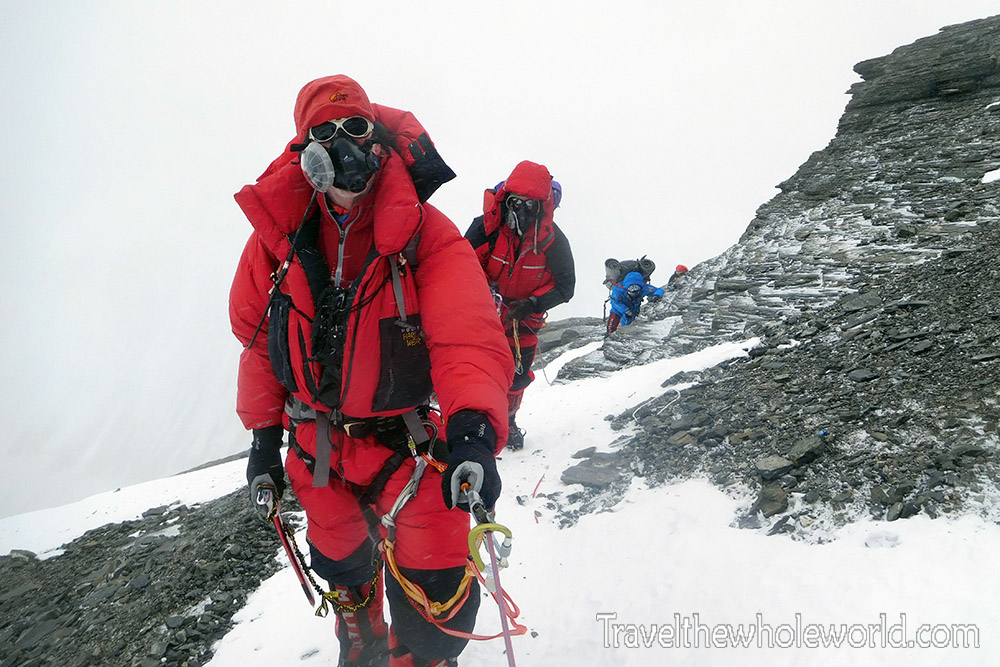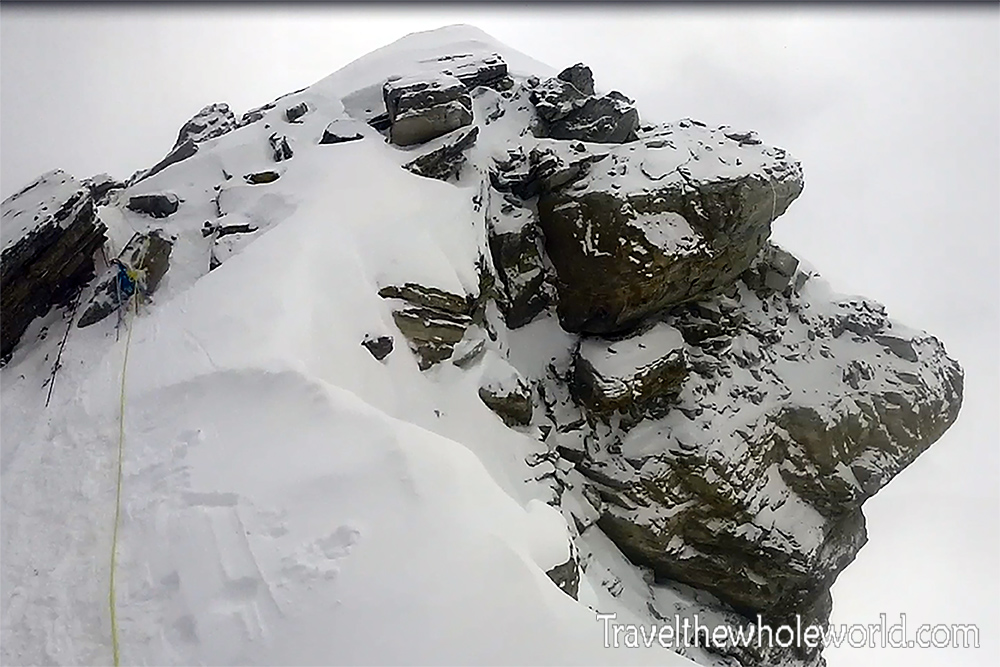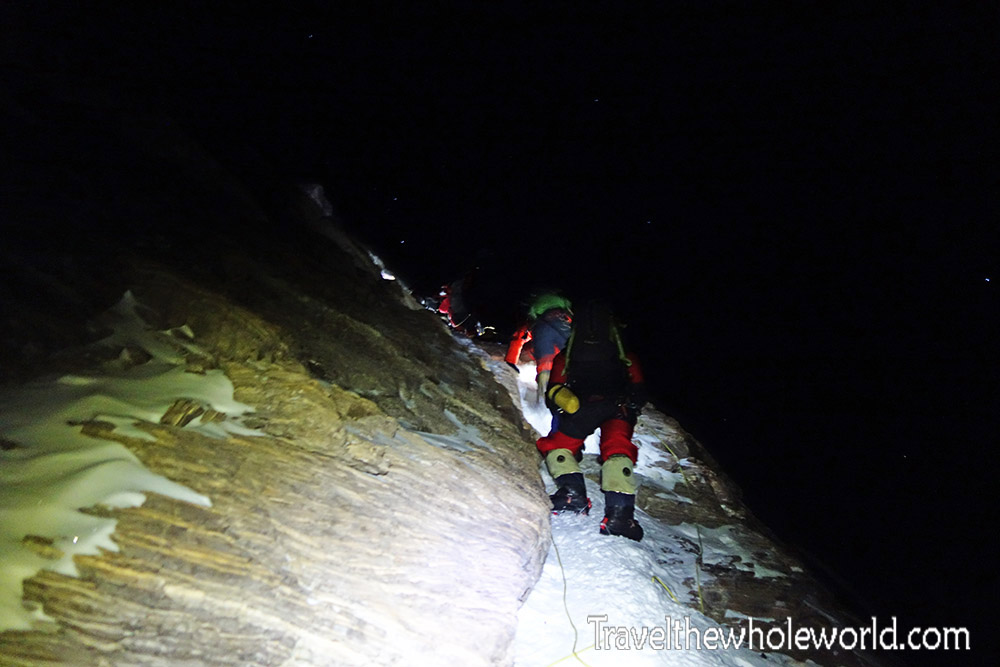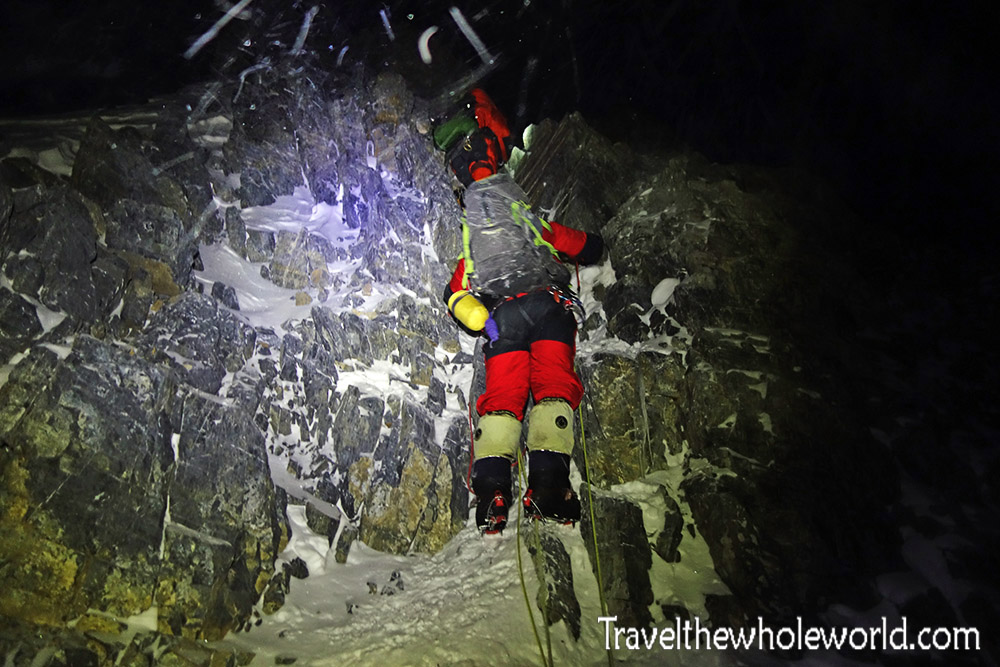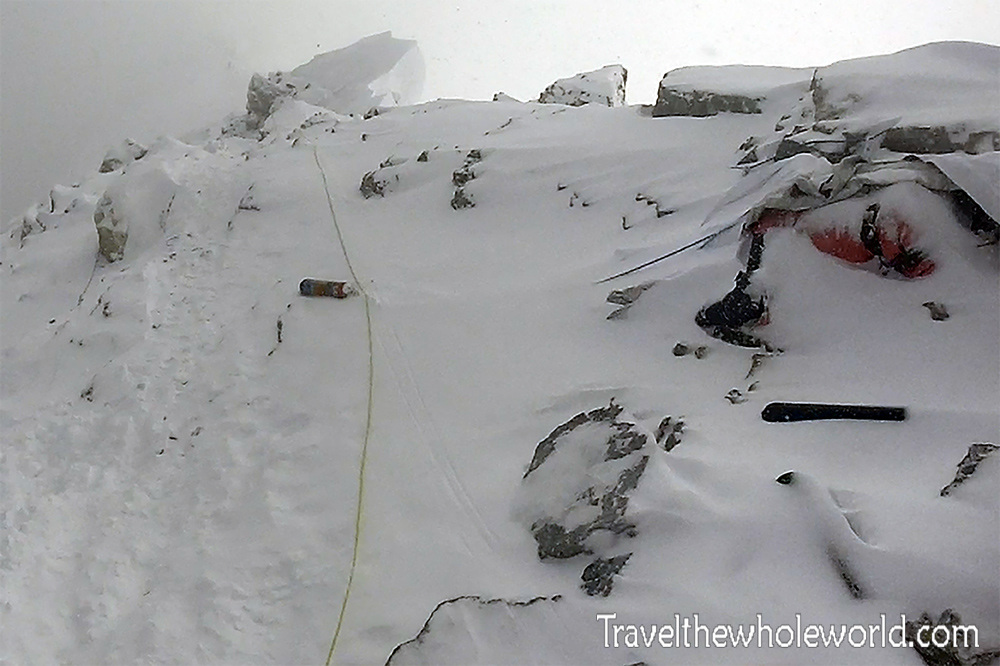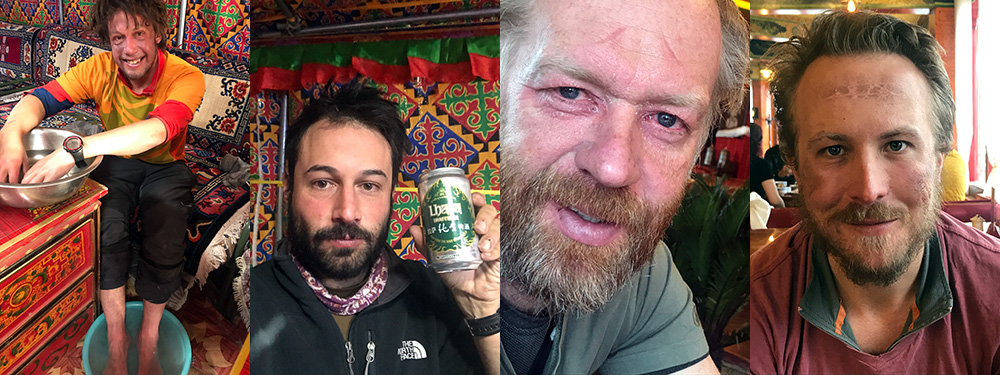Continued from the North Col
From Camp II, the top of Mt. Everest doesn’t appear far at all. It almost looks like you can hike straight towards it without a rope, but the route is actually deceptively exposed and steep. Since our Camp II was at 25,500 feet (7,850 meters) we were exactly a vertical kilometer below the summit. It might look like a short distance in the photo above, but we were still two days away from the top of the world.
Leaving Camp II and heading up to Camp III began in some rocky terrain. Since our Camp II was so high we only had about 1,000 feet (300 meters) to gain. The photo above shows some of my team climbing past 26,000 feet (8,000 meters) where we officially entered in the death zone. From here on out, our time at this altitude was limited. Once in the death zone, you begin dying, even if you are resting and breathing supplemental oxygen. Most use four days as the maximum window until you pass away from the lack of oxygen and the extremely low pressure of the atmosphere.
I took this photo immediately after entering the Death Zone. I assume these patterns are the result of high winds etching the terrain over time. These are the highest rock formations on earth! Knowing we were so high was inspiring, but regardless the climb to Camp III was torture. The anxiety of not knowing what would happen with our bodies, the weather, and so many other factors was burning in my mind each step of the way. When we were just below Camp III, we came across a climber who had just died and was attached to the main line with a prusik. This meant that in order to pass his body, we had to disconnect from the fixed rope, and then reattach on the other side of him. I remember he was frozen rock solid and laying down as if he was taking a nap. He had his ice ax in the snow just in front of his face, with what looked like an expensive altimeter that was still displaying a digital read out. Somehow he had passed away just meters away from the camp. In Nepal last year, I had also seen two people who had died only about 15 minutes below high camp as well.
At Camp III we got inside our tents to rest before our summit attempt. The Death Zone is bad enough that a full day rest can do more harm for the body than good. Our goal was to lay in our tents and eat what we could, then attempt to summit that same night. Camp III on the Tibet side is the highest camp on planet earth, surpassing the Nepal side’s camp by 1,000 feet (300 meters). It’s not a fun place to be by any means. The extra 1,000 feet is significant, so I did feel it was much more difficult to be here than Nepal’s summit camp.
As we laid in our tents the mood was terrible. The dead climber was all on our minds. I felt as if I had no energy. Even rolling over in my sleeping bag was an incredible effort. Nepal’s high camp was on a nice flat area, while Tibet’s high camp seemed so steep, one misstep outside would send you tumbling down the mountain. I was sharing a tent with my friend Ian, but it still felt crowded. Both sides of our sleeping bags where lined with oxygen bottle, food that we had no willpower to eat, and other gear thrown about that we would need for summit day. Last year at high camp someone who was 34 years old had died in his sleep, and I was terrified of having the same fate. I’d switch my oxygen from minimum and give myself an occasional blast at max flow hoping that would somehow minimize the threat.
As the sun began to set, my climbing partner leaned outside to get a view outside. “George, you must have a look! This is the most amazing view I’ve ever seen!” His sudden outburst of enthusiasm seemed very off for such a horrible place. All I had to do was sit up, but the challenge was too great. I told him I’d see it in the morning, or when we descended from the summit. “Mate, it’s truly amazing, you absolutely have to have a look!” It seemed like for the next 15 minutes he kept shouting my name and encouraging me to see the sun setting on the highest camp on the planet. I debated it back and forth in my mind, but I never got up. My climbing partner Ian was the first person to climb Mt. Everest with terminal cancer. Although I never saw that amazing view that night, it was enough for me that he did.
When the sun set and darkness consumed everything, the environment felt even scarier. At midnight we made the incredible effort to put our boots and crampons on, and prepare for what I assumed would be the most difficult day of my life. From here on out the majority of our climb was in darkness. Since my camera had died, the only photos I have are screen shots from my GoPro during the descent, or shots that others took that I happened to be in. Both photos above and below are just above Camp III. In the photo below, you can barely see tents in the distance if you know what you’re looking for. Hopefully that give some perspective on how steep the camp is and why it’s not the most ideal place to sleep.
It took us over an hour to get ready, but by 1am, the five of us continued the climb to the top of the world. The photo above is not even an hour above high camp. You can see some rocks that require a quick scramble. They weren’t extremely difficult, but at 27,000 feet (8,300 meters) it’s certainly a challenge. Also keep in mind that we did this for the first time in pitch black darkness.
The initial part of the climb has you going straight up towards the summit ridge. You’re climbing steep and snowy terrain with occasional light scrambling until you top out above 27,500 feet (8,400 meters). Since it was so dark, I couldn’t see anything past a few feet in front of me. This was a huge psychological challenge for me, it’s always nice to be able to see the light at the end of the tunnel, but each rock I scrambled over I would just find another one above me.
Once I climbed the wall however, I could tell that I was finally on the summit ridge. Despite how much difficulty I had getting ready and laying around the tent, I felt like I had a reasonable amount of energy in the beginning of the climb. As long as things stayed the same, I felt like I could maintain this pace to the summit. We had about ten hours of total climbing, which might sound close after already climbing for a month and a half. The final ten hours seemed like an eternity to me, especially when I was counting every second.
Things continued to go relatively well until I hit 28,000 feet (8,500 meters). Everything suddenly took a wild turn and not in a good way. In this photo above, I’m second in front of the photographer, and this was probably right when it happened. I recall feeling like the world began to violently spin and then suddenly stopped and resettled. I paused and had no idea what had just happened. My first thoughts were to keep this a secret. I found it odd but continued climbing onward.
Luckily the spinning thing never came back, but I had a new problem now. I’d be lost in my own thoughts, almost like I was in a deep day dreaming and then suddenly spring back to consciousness. This was terrifying, because sometimes when I’d come back I’d be in a reasonably safe position. Other times I’d find myself on a narrow windy ledge, holding on to a rope with darkness below me as far as I could see. It’s extremely difficult to describe, but it was something I didn’t understand and have never experienced before. It almost felt like I had been back home and suddenly had just magically appeared on Mt. Everest in the middle of the night. The expedition leader hadn’t planned to climb anymore after the wind storm, but at the last minute rejoined us. By chance, he happened to be right behind me, and I finally told him what was happening and that I would probably be turning around.
My expedition leader noted I looked and was acting normal and that I showed no signs of cerebral edema. He asked me, “Do you know who I am?” and “Am I on your side?” I said of course to both. I’ve had cerebal edema before on another mountain, and didn’t believe I had it on Everest. When this had happened to me years ago, I found myself stumbling around like I was drunk, unable to speak coherently, and I was confused about my location on the mountain.
All I knew was something was very wrong and at these altitudes it wasn’t a safe place to experiment. Nevertheless I decided to continue and came across another one of those narrow ledges that had to be crossed. Since it was 3 or 4 am now, everything below the ledge was was still a pitch black eternal abyss. Somewhere on the ledge I faded out again, but when I returned I found right in front of me the most morbid body I had ever seen. Somehow his knees were raised up like he was doing sit-ups, but his body was hanging downwards. By the condition of him he looked dead for years, maybe even a decade. I didn’t understand how someone could have died in that position. I had passed by a famous spot earlier in the night where two famous bodies had remained frozen in place from the 1990’s. Apparently the earthquake had shaken them down the mountain, and perhaps that’s what had happened here.
After I passed him I couldn’t help but wonder if I’d be in a similar state soon if I didn’t leave. Trying to climb Mt. Everest while feeling like you’re going in and out of consciousnesses is absolutely insane. I told the expedition leader again that I felt like I was on a suicide mission. He checked my eyes with his headlamp and said I looked fine, but the decision was up to me. Other than what I was telling him he said he had no reason to suspect anything was wrong with me. Up ahead was the first technical climb of the day. He suggested I climb it as a test to see how I felt.
On the Tibet side of the mountain, Everest has three steps or vertical rock climbing areas just before the summit. I was able to climb the first tstep without any issues. I didn’t really find it to be all that challenging as a matter of fact. The second step is considered to be the most difficult, and the third step is the easiest of the three. These photos above and below show me and another climber on the second step. After I made it easily up the second step we concluded my condition was probably just extreme fatigue. Normally you only spent two or three nights above 23,000 feet (7,000 meters) before heading back down. We had spent an incredible week above this altitude, without much food, sleep or decent rest. On top of that, the wind storm that had destroyed our camp at 25,500 feet had forced us down to 23,000 feet and only for us to return back to a day later. None of us had truly slept in days because of all these factors. I try to be a logical person, even when not fully conscious on Mt. Everest. This answer made sense to me. It had been hours since I had first noticed something wrong, and it certainly hand’t gotten worse. Climbing higher with altitude problems would immediately exacerbate them. I likely would have been unable to move by now and left behind like so many others. At this point, I made a full mental commitment to continue to the summit.
At this point, I wasn’t very far from the summit. I realized even if something happened and my condition worsened I’d probably at least make it to the summit. A part of my mind yelled out, I’m going to climb Mt. Everest! Soon after that I approached what was supposed to be the easiest of the three steps.
I had climbed up to the base and had to look for handholds. I wasn’t sure exactly where to step and what to grab on to. This is silly I thought. I didn’t want to slip and have my oxygen bottle fly down the mountain like I had feared last year. I pulled myself up while completely out of breath and found the third step the hardest. I recalled thinking maybe I had been mistaken about the second being the bigger challenge. After the climb was over, the expedition leader who had seen me go up the third step said I had gone the wrong way, and they had tried to call out to me but it was too late. He said his top climbing Sherpa who was behind me felt he had to follow, and as he climbed up he had a massive slip! The photo above shows my figure 8 that I used to rappel on the way down, below is another photo of the third step taken from its base.
After the third step there were a few dead climbers in the snow. This one above was recorded by my Go-Pro. I had refused to actually take a straight up photograph with my camera. This still scared me, but Whatever was wrong with me hadn’t gotten worse. The dead here are a depressing part of the climb, and it really can play games with your mind. After I saw the dead mummified climber hanging upside down I decided to do my best to avoid seeing anymore by just focusing on what was directly in front of me. A Sherpa who had climbed with us claimed he had counted 13 on the way up and would never climb the Tibet side again.
By now I was just below the summit. From this point, I had to climb up a snowy hill, then make an annoying right turn to traverse the base of another rock formation photographed above. After the traverse we had to climb directly upwards over some icy rocks until making yet another hard right over a snowy cornice ridge.
I reached the top of the world roughly at 8am on the 27th of May. It was windy and snowy, and there was another expedition on the summit already but this was the least of my concerns. I wish I could say I was overwhelmed with joy and triumph, but I was mostly concerned about what was going on with my head. While part of me couldn’t believe I had climbed Mt. Everest and was standing on top of the world, a bigger part of me was yelling to get the hell out of here. I had been curious if the Tibet and Nepal routes met before the summit or at the top. As it turns out, the Tibet route and the Nepal route literally meet at the summit. After getting some photos and enjoying the lack of a view, we decided to head back down, I was going home.
I was lucky that despite not being fully present on summit day, I still felt strangely energetic. The goal was to return to Camp III for a night of rest and then head back down to the North Col. I was able to pass Camp III, then Camp II and go all the way down to the North Col in the same day.
Whatever was wrong with my conscious didn’t improve as I descended to lower altitude. By the time I was going down the snow slope to the North Col I was in a full white out and blizzard. I had been alone for hours, but would have sworn on my life that at one point I saw my expedition leader just above me staring at me as I descended. I was also worried that I was somehow lost, even though that was impossible on such a narrow ridge. Finally I made it to the North Col in a dream like state and crashed.
Sleeping at 23,000 feet (7,000 meters) was like sleeping at sea level. I had zero concerns about my oxygen running out, so I put what I had left on full blast and went to sleep. Previously my record for sleeping at this altitude was maybe two or three hours in a row, but somehow I slept ten consecutive hours which is probably a record!
In the morning, I woke up to find myself all alone except for one other climber. I got some bad news from one of the Sherpas in the camp. The remaining five of us had all made the summit, but three were trapped at Camp III. I was told one was blind, one incapacitated, and another had frostbite. Even worse, they were running out of oxygen. Looking up the North Ridge I could see the conditions were bad and it was extremely windy. If that information was true, I was sacred that all none of them might make it down alive.
The North Col is pretty well protected from the elements, so I naively felt safe and that I could get back down to ABC without much effort. As I left camp I realized I was totally destroyed. Even worse, the storm yesterday had buried the ropes in over a foot of snow and I was without oxygen. At sea level it might have taken seconds to dig out the first rope, but I kicked into the snow with my crampons and occasionally used my hands with out much progress. It took 15 minutes to find the first one.
I was also without much water and extremely dehyrdated. I was trying to ration what little I had left. During the decent a Sherpa came up behind me and I offered him to go in front. He refused, claiming he was too tired. To be honest, I thought he was just saying that so I’d have to go continue breaking trail and digging the ropes out. Eventually he did go in front of me and I could see he was as destroyed as I was. I let him have some of my water and he nearly drank the entire thing.
My descent down the North Col took forever, but when I made it back into the rocky terrain below I was finally off the mountain and truly safe. From here I had a flat hike over a snowfield followed by a trail at 21,500 feet (6,500 meters). I was so exhausted that I couldn’t walk for more than 10 steps without stopping. I tried to count 15 steps without stopping but I couldn’t do it. Once I sat down for 20 minutes. I had no more water and not much food left. I hadn’t planned this part of the day well. What should have been a 30 minute hike took me hours. I had been naive enough to think I’d go to Base Camp today but instead I hardly made it to ABC.
The next morning I asked someone with a radio what had happened to everyone up top, and to my surprise my expedition leader responded to me from his tent. “We’re all here!” I didn’t believe him at first but it was true, everyone had somehow made it down safely in the middle of the night. That day we all dragged ourselves to Base Camp and were officially done with the expedition. Photos of us above show what the mountain did to us. I definitely looked much worse last year!
Once back in Lhasa Tibet, we all fulfilled our shameful fantasies of KFC and having a few drinks. Despite all that, we all woke up starving each morning and I realized I had 15 lbs to gain back. I was also happy to go to a barbershop once back in Nepal, and have a transformation seen above. There’s absolutely nothing like getting back to warm air again and celebrating with your friends. Once back home it took some time for our victory to sink in. We had all claimed on the mountain that we’d never do anything like this again, but we didn’t even get ten days of a break before we began to miss the experience. A few months later the entire climb felt more like a dream than a reality. I recall going to the gym one day and seeing some clouds in the sky and had to remind myself that only a few months ago I had been sleeping up there. It’s going to be a long time until my next adventure, but my next big mountain and final peak is Massif Vinson in Antarctica!

